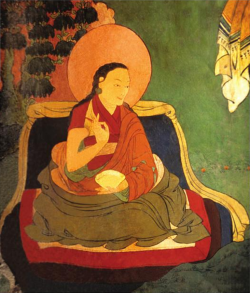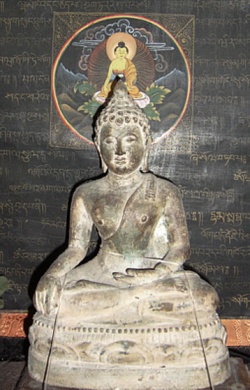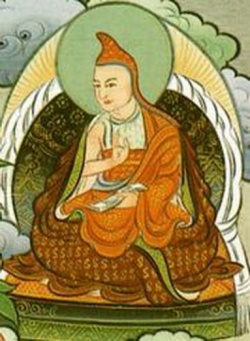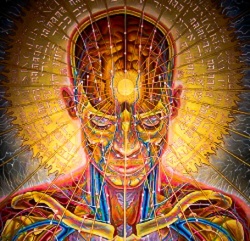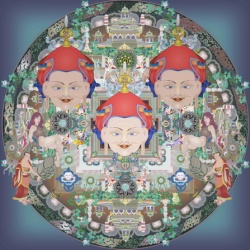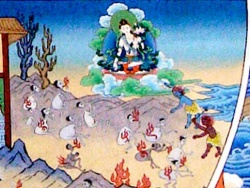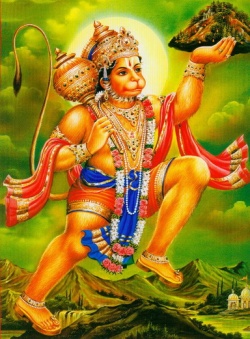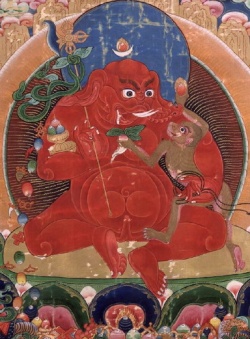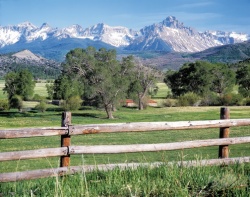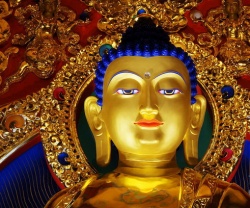Difference between revisions of "Chokyi Dronma"
(Created page with "Samding Dorje Phagmo (Wylie: {{BigTibetan|བསམ་སྡིང་རྡོ་རྗེ་ཕག་མོ}}) is the highest {{Wiki|female}} incarnation in [...") |
|||
| Line 1: | Line 1: | ||
| − | [[Samding Dorje Phagmo]] ([[Wylie]]: {{BigTibetan|བསམ་སྡིང་རྡོ་རྗེ་ཕག་མོ}}) is the [[highest | + | [[File:Phagmo incarnation.png|thumb|250px|]]<nomobile>{{DisplayImages|1884|1909|27|1242|1566|1251|1324|1457|151|309|2626|1955}}</nomobile> |
| + | |||
| + | |||
| + | |||
| + | |||
| + | |||
| + | |||
| + | [[Samding Dorje Phagmo]] ([[Wylie]]: {{BigTibetan|[[བསམ་སྡིང་རྡོ་རྗེ་ཕག་མོ]]}}) is the [[highest female incarnation in Tibet]] and the third highest-ranking [[person]] in the {{Wiki|hierarchy}} after the [[Dalai Lama]] and the [[Panchen Lama]]. | ||
| + | |||
| + | She was listed among the [[highest-ranking reincarnations]] at the time of the [[5th Dalai Lama]], [[recognized]] by the [[Tibetan government]] and [[acknowledged]] by the [[emperors]] of [[Qing]] [[China]]. | ||
| + | |||
| + | She was the [[student]] of the famous polymath [[Thang Tong Gyalpo]], who first identified her as a [[tulku]] of [[Vajravārāhī]]. | ||
| + | |||
| + | |||
History and background | History and background | ||
| − | |||
| − | |||
| − | [[Charles Alfred Bell]] met the [[tulku]] in 1920 and took photographs of her, calling her by the [[Tibetan]] [[name]] for [[Vajravarahi]], [[Dorje Pamo]] (which he translated as "[[Thunderbolt Sow]]"), in his [[book]]. The current [[incarnation]], the 12th of this line, resides in [[Lhasa]]. where she is known as {{Wiki|Female}} [[Living Buddha]] [[Dorje Palma]] by [[China]]. | + | Her seat, [[Samding Monastery]] "[[Temple of Soaring Meditation]]", is associated with the [[Bodong school]] of [[Tibetan Buddhism]]. |
| + | |||
| + | It was unique because half of the inhabitants were [[monks]] and the other half were [[nuns]] and its head was a woman. It | ||
| + | |||
| + | The [[female tulku]] who was the [[abbess]] of [[Samding]] was [[traditionally]] a [[nirmanakaya]] [[emanation]] of [[Vajravārāhī]]. | ||
| + | |||
| + | The [[lineage]] started in the 15th century with the {{Wiki|princess}} of [[Gungthang]], [[Chökyi Drönma]] ([[Wylie]]: [[chos kyi sgron me]], 1422–1455). | ||
| + | |||
| + | |||
| + | She became known as [[Samding Dorje Pagmo]] ([[Wylie]]: [[bsam lding rdo rje phag mo]]) and began a line of {{Wiki|female}} [[tulkus]], [[reincarnate lamas]]. She was a contemporary of the [[1st Dalai Lama]] (1391–1474) and her [[teacher]] [[Bodong Panchen Chogley Namgyal]] also was one of his [[teachers]]. | ||
| + | |||
| + | |||
| + | She [[manifested]] at [[Samding Monastery]] in order to tame [[Yamdrok Lake]], a [[sacred lake]] as well as a [[dangerous]] flashpoint for massive flooding events in [[Tibet]]. | ||
| + | |||
| + | However, her effects were more {{Wiki|practical}}: as [[abbess]] of [[Samding]], she stopped the invasion of the {{Wiki|Dzungars}}, who were reportedly terrified of her great [[siddhi]] [[powers]]. | ||
| + | |||
| + | |||
| + | When faced with her [[anger]] - reputedly by turning the 80 [[śrāmaṇerīs]] under her care into [[furious]] wild sows - they left the goods and valuables they had plundered as [[offerings]] at her [[monastery]] and fled the region. | ||
| + | |||
| + | |||
| + | [[Charles Alfred Bell]] met the [[tulku]] in 1920 and took photographs of her, calling her by the [[Tibetan]] [[name]] for [[Vajravarahi]], [[Dorje Pamo]] (which he translated as "[[Thunderbolt Sow]]"), in his [[book]]. | ||
| + | |||
| + | The current [[incarnation]], the 12th of this line, resides in [[Lhasa]]. where she is known as {{Wiki|Female}} [[Living Buddha]] [[Dorje Palma]] by [[China]]. | ||
| + | |||
| + | |||
| + | The [[present incarnation]] [i.e. in 1882] of the [[divine]] [[Dorje Phagmo]] is a lady of twenty-six, [[Nag-wang rinchen kunzag wangmo]] by [[name]]. | ||
| + | She wears her [[hair]] long; her face is agreeable, her manner dignified, and somewhat resembling those of the Lhacham, though she is much less prepossessing than she. | ||
| − | + | It is required of her that she never take her rest {{Wiki|lying}} down; in the daytime she may recline on cushions or in a chair, but during the night she sits in the position prescribed for [[meditation]]. | |
| − | hen the Jungars had given up all [[idea]] of sacking [[Samding]], suddenly the pigs disappeared to become venerable-looking [[lamas]] and [[nuns]], with the saintly [[Dorje Phagmo]] at their head. Filled with astonishment and veneration for the [[sacred]] [[character]] of the lady [[abbess]], the chief made immense presents to her [[lamasery]]. | + | In 1716, when the Jungar invaders of [[Tibet]] came to Nangartse, their chief sent [[word]] to [[Samding]] to the [[Dorjo Phagmo]] to appear before him, that he might see if she really had, as reported, a pig's head. |
| + | |||
| + | A mild answer was returned to him; but, incensed at her refusing to obey his summons, he tore down the walls of the [[monastery of Samding]], and broke into the [[sanctuary]]. | ||
| + | |||
| + | He found it deserted, not a [[human being]] in it, only eighty pigs and as many sows grunting in the congregation hall under the lead of a big sow, and he dared not sack a place belonging to pigs. | ||
| + | |||
| + | |||
| + | hen the Jungars had given up all [[idea]] of sacking [[Samding]], suddenly the pigs disappeared to become venerable-looking [[lamas]] and [[nuns]], with the saintly [[Dorje Phagmo]] at their head. | ||
| + | |||
| + | Filled with astonishment and veneration for the [[sacred]] [[character]] of the lady [[abbess]], the chief made immense presents to her [[lamasery]]. | ||
[[Samding Monastery]] was destroyed after 1959 but is in the process of being restored. | [[Samding Monastery]] was destroyed after 1959 but is in the process of being restored. | ||
| − | |||
| − | |||
| − | |||
| − | |||
| − | |||
| − | |||
| − | |||
| − | |||
| − | |||
| − | |||
| − | |||
| − | |||
| − | |||
| − | In premodern [[Tibet]], the successive [[incarnations]] of [[Dorje Pakmo]] were treated with {{Wiki|royal}} privilege and, along with the [[Dalai and Panchen]] [[Lamas]], (and when they were in [[Tibet]], the {{Wiki|Chinese}} [[Ambans]]) were permitted to travel by palanquin or sedan chair. Unlike most other [[nuns]], [[Dorje Pakmo]] was allowed to wear her [[hair]] long, but was never to [[sleep]] {{Wiki|lying}} down – in the day she could [[sleep]] sitting up in a chair, but was expected at night to remain in a [[meditative]] position. | + | [[Incarnation lineage]] |
| + | |||
| + | |||
| + | [[Samding Dorje Phagmo]] I, [[Chokyi Dronma]] | ||
| + | [[Samding Dorje Phagmo]] II, [[Kunga Zangmo]] (1459-1502) | ||
| + | [[Samding Dorje Pakmo]] III, [[Nyendrak Zangmo]] (1503-1542) | ||
| + | [[Samding Dorje Phagmo]] IV, [[Orgyen Tsomo]] (born 1543?) | ||
| + | [[Samding Dorje Phagmo]] V, [[Yeshe Tsomo]] (17th century) | ||
| + | [[Samding Dorje Phagmo]] VI, [[Dechen Trinle]] Tsomo (17th century) | ||
| + | [[Samding Dorje Phagmo]] VII, [[Chodron Wangmo]] ([[died]] 1746) | ||
| + | [[Samding Dorje Phagmo]] VIII, [[Kelzang Choden Wangmo]] (1746-1774) | ||
| + | [[Samding Dorje Phagmo]] IX, [[Choying Dechen Tsomo]] ([[died]] 1843) | ||
| + | [[Samding Dorje Phagmo]] X, [[Ngawang Kunzang Dechen Wangmo]] (born 1857) | ||
| + | [[Samding Dorje Phagmo]] XI, [[Tubten Choying Pelmo]] (born 1896) | ||
| + | [[Samding Dorje Phagmo]] XII, [[Dechen Chokyi Dronma]] (born 1938?) | ||
| + | |||
| + | |||
| + | |||
| + | In premodern [[Tibet]], the successive [[incarnations]] of [[Dorje Pakmo]] were treated with {{Wiki|royal}} privilege and, along with the [[Dalai and Panchen]] [[Lamas]], (and when they were in [[Tibet]], the {{Wiki|Chinese}} [[Ambans]]) were permitted to travel by palanquin or sedan chair. | ||
| + | |||
| + | Unlike most other [[nuns]], [[Dorje Pakmo]] was allowed to wear her [[hair]] long, but was never to [[sleep]] {{Wiki|lying}} down – in the day she could [[sleep]] sitting up in a chair, but was expected at night to remain in a [[meditative]] position. | ||
[[Chokyi Dronma]] | [[Chokyi Dronma]] | ||
| − | The first [[Dorje Phagmo]], [[Chokyi Dronma]], was a {{Wiki|princess}} of the then {{Wiki|independent}} {{Wiki|kingdom}} of [[Gungthang]] in southwestern [[Tibet]] in the 15th century. She [[married]] to the {{Wiki|prince}} of southern [[Lato]] ([[La stod lho]]) who is defined as a keen supporter of [[Bonpo]] practices[citation needed] – but, after the [[death]] of her only child, a daughter, she renounced her [[family]] and {{Wiki|royal}} {{Wiki|status}} to become a [[Buddhist nun]] circa 1442. | + | The first [[Dorje Phagmo]], [[Chokyi Dronma]], was a {{Wiki|princess}} of the then {{Wiki|independent}} {{Wiki|kingdom}} of [[Gungthang]] in southwestern [[Tibet]] in the 15th century. |
| + | |||
| + | She [[married]] to the {{Wiki|prince}} of southern [[Lato]] ([[La stod lho]]) who is defined as a keen supporter of [[Bonpo]] practices[citation needed] – but, after the [[death]] of her only child, a daughter, she renounced her [[family]] and {{Wiki|royal}} {{Wiki|status}} to become a [[Buddhist nun]] circa 1442. | ||
| + | |||
| + | She rapidly became famous as a dynamic and inspirational follower, possibly a [[tantric consort]] ([[phyag rgya ma]]), of three of the outstanding [[religious]] [[tantric]] [[masters]] of the {{Wiki|era}}. | ||
| + | |||
| + | She was also recognised as a [[master]] in her [[own]] right and as the [[spiritual]] heir of her main [[teacher]]. | ||
| + | |||
| + | She contributed to some of the most significant works of [[art]], [[architecture]], and {{Wiki|engineering}} of her time and had seminal influence in the [[development]] of [[printing]]. | ||
| + | |||
| + | Furthermore, she expressed a particular commitment toward women, promoting their [[education]], establishing [[nunneries]], and even creating [[religious]] dances that included roles for them. | ||
| + | |||
| + | [[Chokyi Dronma]] [[died]] at the age of [[thirty-three]], leaving a {{Wiki|tangible}} mark on history not only through her [[own]] [[deeds]] but even more through what happened after her [[death]]: | ||
| + | |||
| + | her [[disciples]] searched for the girl in whom she had [[reincarnated]] and thus [[initiated]] a line of {{Wiki|female}} [[incarnations]] that became the first and most famous in [[Tibet]]." | ||
| + | |||
| + | |||
| + | |||
| + | |||
| + | [[Chokyi Dronma]] was a leading figure in the [[Tibetan]] [[Bodongpa]] [[tradition]] which gradually waned under [[Gelugpa]] {{Wiki|rule}}, but is being gradually restored today. | ||
| + | |||
| + | She [[died]] at the [[Manmogang Monastery]] in [[Tsari]] to the [[southeast]] of [[Dakpo]], near the [[Indian]] border, in 1455. Diemberger also says that " | ||
| + | |||
| + | the [[Venerable]] Lady passed away into the [[dakinis]]' [[heaven]] ([[khecara]]), her true home. She left her [[skull]] with special features as the [[wish-fulfilling gem]] of the great [[meditation]] center of Tsagong. | ||
| + | |||
| + | The great [[siddha]] [[[Thangtong Gyalpo]]] had said earlier, 'A [[skull]] with special features will come to this [[sacred]] place, together with a mountain dweller from [[Ngari]]', and thus the {{Wiki|prophecy}} had come true, greatly enhancing the [[devotion]] of the [[Kongpo]] [[people]]."] | ||
| − | |||
| − | |||
Kunga [[Zangmo]] | Kunga [[Zangmo]] | ||
| + | |||
| + | |||
According to Diemberger the second [[Dorje Phagmo]] was [[Kunga Sangmo]] ([[wylie]]: [[Kun dga' bzang mo]]) (1459–1502). | According to Diemberger the second [[Dorje Phagmo]] was [[Kunga Sangmo]] ([[wylie]]: [[Kun dga' bzang mo]]) (1459–1502). | ||
| − | |||
| − | The | + | |
| + | [[Choying Dechen Tsomo]] | ||
| + | |||
| + | The [[ninth Dorje Phagmo]] -[[Choying Dechen Tshomo]]-, for example, became a renowned [[spiritual master]] not only for [[Samding]] but also for the [[Nyingma tradition]], discovered some [[terma]] and [[died]] at [[Samye]]. | ||
| + | |||
| + | Her [[skull]] is still preserved and [[worshipped]] as a {{Wiki|holy}} [[relic]] in the [[Nyingmapa monastery]] on the [[island]] of Yumbudo in [[Yamdrok Tso]] Lake. | ||
| + | |||
| + | |||
Present [[Samding Dorje Phagmo]] | Present [[Samding Dorje Phagmo]] | ||
| − | The {{Wiki|present}} (12th) | + | |
| + | The {{Wiki|present}} ([[12th) [Samding Dorje Pakmo Trülku]] is [[Dechen Chokyi Dronma]] [[Dêqên Qoizhoin]] [[Rinpoche]], who was born in 1938/1942 (?). | ||
The twelfth [[Samding Dorje Pakmo]] was very young at the time of the {{Wiki|Chinese}} {{Wiki|occupation}}, but her exact date of [[birth]] is contested, some [[people]] claiming she was born a year before the [[death]] of the previous [[incarnation]] (and therefore cannot be the true [[reincarnation]]). | The twelfth [[Samding Dorje Pakmo]] was very young at the time of the {{Wiki|Chinese}} {{Wiki|occupation}}, but her exact date of [[birth]] is contested, some [[people]] claiming she was born a year before the [[death]] of the previous [[incarnation]] (and therefore cannot be the true [[reincarnation]]). | ||
| − | However, she was | + | However, she was recognized by the {{Wiki|present}} [[14th Dalai Lama]] as a true [[incarnation]] and served as a vice [[president]] of the [[Buddhist]] Association in 1956 while he was [[president]], and the [[10th Panchen Lama]] also a vice [[president]]. |
| + | |||
| + | She went to [[Lhasa]] in 1958 and received the [[empowerment]] of [[Yamantaka]] from the [[Dalai Lama]] and the [[empowerment]] of [[Vajrayogini]] from the [[Dalai Lama's]] tutor, [[Trijang Rinpoche]]. | ||
| + | |||
| + | She was trained in the [[Bodongpa]] [[tradition]] but remains the head of the [[Samding Monastery]] while also holding the post of a high government cadre in the {{Wiki|Tibet Autonomous Region}}. | ||
| + | |||
| + | She has, as a result, been accused by many of "collaborating" with the {{Wiki|Chinese}}. | ||
| + | |||
| + | After the {{Wiki|2008 Tibetan unrest}} and prior to the 2008 Summer Olympics in {{Wiki|Beijing}}, the {{Wiki|Chinese}} official government news agency Xinhua said that the twelfth [[Samding Dorje Phagmo]], | ||
| + | |||
| + | who is also the vice-chairwoman of the [[standing]] committee of the [[Tibetan Autonomous Regional People's Congress]], was quoted saying that, | ||
| + | |||
| + | "The [[sins]] of the [[Dalai Lama]] and his followers seriously violate the basic teachings and [[precepts]] of [[Buddhism]] and seriously damage [[traditional]] [[Tibetan Buddhism's]] normal order and good reputation." | ||
| + | |||
| + | She reportedly told Xinhua that, "Old [[Tibet]] was dark and {{Wiki|cruel}}, the serfs lived worse than [[horses]] and cattle." | ||
| − | |||
| − | |||
Names | Names | ||
| − | |||
| − | Also: "The princess's three main names seem to refer to three {{Wiki|distinct}} modes of [[manifesting]] herself in different contexts: [[Konchog Gyalmo]] ([[Queen of the Jewel]]), her [[birth]] [[name]]; [[Chokyi Dronma]] ([[Lamp of the Dharma]]), the [[name]] she was given when she was [[ordained]] as a {{Wiki|novice}}; and [[Dorje Phagmo]] ([[Vajravarahi]]), the [[name]] attributed to her when she was revealed as an [[emanation]] of this [[deity]]. | + | Diemberger writes: "Three names in particular frame her [[Wikipedia:Identity (social science)|identity]] according to a classical [[Tibetan]] threefold model: as a {{Wiki|royal}} {{Wiki|princess}} she was called [[Queen of the Jewel]] ([[Konchog Gyalmo]]), |
| + | |||
| + | her 'outer' [[name]]; when she took her [[vows]] she became known as [[Lamp of the Doctrine]] ([[Chokyi Dronma]]), her 'inner' [[name]]; | ||
| + | |||
| + | as a [[divine]] [[incarnation]] she was called [[Thunderbolt Female Pig]] ([[Dorje Phagmo]]), her 'secret' [[name]]. | ||
| + | |||
| + | " The [[wylie]] transliteration is given by Diemberger as [[Chos kyi sgron me]]. | ||
| + | |||
| + | |||
| + | Also: "The princess's three main names seem to refer to three {{Wiki|distinct}} modes of [[manifesting]] herself in different contexts: [[Konchog Gyalmo]] ([[Queen of the Jewel]]), | ||
| + | |||
| + | her [[birth]] [[name]]; [[Chokyi Dronma]] ([[Lamp of the Dharma]]), the [[name]] she was given when she was [[ordained]] as a {{Wiki|novice}}; and [[Dorje Phagmo]] ([[Vajravarahi]]), the [[name]] attributed to her when she was revealed as an [[emanation]] of this [[deity]]. | ||
| + | |||
| + | |||
| + | In an introductory [[letter]], written by [[Thangtong Gyalpo]] before she departed from Northern [[Lato]] in 1454, he presented her like following: | ||
| + | |||
| + | "Now there is a lady who stems from the {{Wiki|royal}} [[lineage]] of the [[Gods]] of [[Clear Light]] ('[[Od gsal lha]]) who is devoted to [[spiritual]] [[liberation]] and to the [[benefit]] of [[all living beings]]. | ||
| + | |||
| + | Her outer [[name]] is [[Lady Queen of the Jewel]] ([[bDag mo dKon mchog rgyal mo]]); her [[inner name]] is [[Female Teacher Lamp of the Doctrine]] ([[sLob dpon ma Chos kyi sgron ma]]); her secret [[name]] is [[Vajravarahi]] ([[rDo rje phag mo]]). Her residence is undefined." | ||
| + | |||
| − | |||
Hats | Hats | ||
| + | |||
The {{Wiki|distinctive}} black hat of the [[Samding Dorje Phagmo]], which can be seen in both [[ancient]] and {{Wiki|modern}} mural paintings and in photographs of the later [[reincarnations]], is very similar to that of the [[Karmapa]] and is linked to the [[dakinis]] and [[Khandro]] [[Yeshe Tshogyal]] in particular. | The {{Wiki|distinctive}} black hat of the [[Samding Dorje Phagmo]], which can be seen in both [[ancient]] and {{Wiki|modern}} mural paintings and in photographs of the later [[reincarnations]], is very similar to that of the [[Karmapa]] and is linked to the [[dakinis]] and [[Khandro]] [[Yeshe Tshogyal]] in particular. | ||
| − | |||
| − | According to Diemberger there also is a [[Dorje Phagmo]] line in [[Bhutan]]. She writes: Currently there is a [[Dorje Phagmo | + | |
| + | ==Other [[Dorje Phagmoincarnationlineages]]== | ||
| + | |||
| + | |||
| + | |||
| + | According to Diemberger there also is a [[Dorje Phagmo]] line in [[Bhutan]]. | ||
| + | |||
| + | She writes: Currently there is a [[Dorje Phagmo Tulku]] in [[Bhutan]] who was [[recognized]] by the [[Sakya Lama]] [[Rikey Jatrel]], considered an [[incarnation]] of [[Thangtong Gyalpo]] (1385–1464 or 1361–1485). | ||
| + | |||
| + | The [[Dorje Phagmo]] is currently a member of the [[monastic community]] of the [[Thangtong Dewachen]] [[nunnery]] at Zilingkha in [[Thimphu]], which follows the [[Nyingma]] and the [[Shangpa Kagyu tradition]]., | ||
{{R}} | {{R}} | ||
[[Category:]] | [[Category:]] | ||
Revision as of 17:43, 23 November 2015
Samding Dorje Phagmo (Wylie: བསམ་སྡིང་རྡོ་རྗེ་ཕག་མོ) is the highest female incarnation in Tibet and the third highest-ranking person in the hierarchy after the Dalai Lama and the Panchen Lama.
She was listed among the highest-ranking reincarnations at the time of the 5th Dalai Lama, recognized by the Tibetan government and acknowledged by the emperors of Qing China.
She was the student of the famous polymath Thang Tong Gyalpo, who first identified her as a tulku of Vajravārāhī.
History and background
Her seat, Samding Monastery "Temple of Soaring Meditation", is associated with the Bodong school of Tibetan Buddhism.
It was unique because half of the inhabitants were monks and the other half were nuns and its head was a woman. It
The female tulku who was the abbess of Samding was traditionally a nirmanakaya emanation of Vajravārāhī.
The lineage started in the 15th century with the princess of Gungthang, Chökyi Drönma (Wylie: chos kyi sgron me, 1422–1455).
She became known as Samding Dorje Pagmo (Wylie: bsam lding rdo rje phag mo) and began a line of female tulkus, reincarnate lamas. She was a contemporary of the 1st Dalai Lama (1391–1474) and her teacher Bodong Panchen Chogley Namgyal also was one of his teachers.
She manifested at Samding Monastery in order to tame Yamdrok Lake, a sacred lake as well as a dangerous flashpoint for massive flooding events in Tibet.
However, her effects were more practical: as abbess of Samding, she stopped the invasion of the Dzungars, who were reportedly terrified of her great siddhi powers.
When faced with her anger - reputedly by turning the 80 śrāmaṇerīs under her care into furious wild sows - they left the goods and valuables they had plundered as offerings at her monastery and fled the region.
Charles Alfred Bell met the tulku in 1920 and took photographs of her, calling her by the Tibetan name for Vajravarahi, Dorje Pamo (which he translated as "Thunderbolt Sow"), in his book.
The current incarnation, the 12th of this line, resides in Lhasa. where she is known as Female Living Buddha Dorje Palma by China.
The present incarnation [i.e. in 1882] of the divine Dorje Phagmo is a lady of twenty-six, Nag-wang rinchen kunzag wangmo by name.
She wears her hair long; her face is agreeable, her manner dignified, and somewhat resembling those of the Lhacham, though she is much less prepossessing than she.
It is required of her that she never take her rest lying down; in the daytime she may recline on cushions or in a chair, but during the night she sits in the position prescribed for meditation.
In 1716, when the Jungar invaders of Tibet came to Nangartse, their chief sent word to Samding to the Dorjo Phagmo to appear before him, that he might see if she really had, as reported, a pig's head.
A mild answer was returned to him; but, incensed at her refusing to obey his summons, he tore down the walls of the monastery of Samding, and broke into the sanctuary.
He found it deserted, not a human being in it, only eighty pigs and as many sows grunting in the congregation hall under the lead of a big sow, and he dared not sack a place belonging to pigs.
hen the Jungars had given up all idea of sacking Samding, suddenly the pigs disappeared to become venerable-looking lamas and nuns, with the saintly Dorje Phagmo at their head.
Filled with astonishment and veneration for the sacred character of the lady abbess, the chief made immense presents to her lamasery.
Samding Monastery was destroyed after 1959 but is in the process of being restored.
Samding Dorje Phagmo I, Chokyi Dronma Samding Dorje Phagmo II, Kunga Zangmo (1459-1502) Samding Dorje Pakmo III, Nyendrak Zangmo (1503-1542) Samding Dorje Phagmo IV, Orgyen Tsomo (born 1543?) Samding Dorje Phagmo V, Yeshe Tsomo (17th century) Samding Dorje Phagmo VI, Dechen Trinle Tsomo (17th century) Samding Dorje Phagmo VII, Chodron Wangmo (died 1746) Samding Dorje Phagmo VIII, Kelzang Choden Wangmo (1746-1774) Samding Dorje Phagmo IX, Choying Dechen Tsomo (died 1843) Samding Dorje Phagmo X, Ngawang Kunzang Dechen Wangmo (born 1857) Samding Dorje Phagmo XI, Tubten Choying Pelmo (born 1896) Samding Dorje Phagmo XII, Dechen Chokyi Dronma (born 1938?)
In premodern Tibet, the successive incarnations of Dorje Pakmo were treated with royal privilege and, along with the Dalai and Panchen Lamas, (and when they were in Tibet, the Chinese Ambans) were permitted to travel by palanquin or sedan chair.
Unlike most other nuns, Dorje Pakmo was allowed to wear her hair long, but was never to sleep lying down – in the day she could sleep sitting up in a chair, but was expected at night to remain in a meditative position. Chokyi Dronma
The first Dorje Phagmo, Chokyi Dronma, was a princess of the then independent kingdom of Gungthang in southwestern Tibet in the 15th century.
She married to the prince of southern Lato (La stod lho) who is defined as a keen supporter of Bonpo practices[citation needed] – but, after the death of her only child, a daughter, she renounced her family and royal status to become a Buddhist nun circa 1442.
She rapidly became famous as a dynamic and inspirational follower, possibly a tantric consort (phyag rgya ma), of three of the outstanding religious tantric masters of the era.
She was also recognised as a master in her own right and as the spiritual heir of her main teacher.
She contributed to some of the most significant works of art, architecture, and engineering of her time and had seminal influence in the development of printing.
Furthermore, she expressed a particular commitment toward women, promoting their education, establishing nunneries, and even creating religious dances that included roles for them.
Chokyi Dronma died at the age of thirty-three, leaving a tangible mark on history not only through her own deeds but even more through what happened after her death:
her disciples searched for the girl in whom she had reincarnated and thus initiated a line of female incarnations that became the first and most famous in Tibet."
Chokyi Dronma was a leading figure in the Tibetan Bodongpa tradition which gradually waned under Gelugpa rule, but is being gradually restored today.
She died at the Manmogang Monastery in Tsari to the southeast of Dakpo, near the Indian border, in 1455. Diemberger also says that "
the Venerable Lady passed away into the dakinis' heaven (khecara), her true home. She left her skull with special features as the wish-fulfilling gem of the great meditation center of Tsagong.
The great siddha [[[Thangtong Gyalpo]]] had said earlier, 'A skull with special features will come to this sacred place, together with a mountain dweller from Ngari', and thus the prophecy had come true, greatly enhancing the devotion of the Kongpo people."]
Kunga Zangmo
According to Diemberger the second Dorje Phagmo was Kunga Sangmo (wylie: Kun dga' bzang mo) (1459–1502).
The ninth Dorje Phagmo -Choying Dechen Tshomo-, for example, became a renowned spiritual master not only for Samding but also for the Nyingma tradition, discovered some terma and died at Samye.
Her skull is still preserved and worshipped as a holy relic in the Nyingmapa monastery on the island of Yumbudo in Yamdrok Tso Lake.
Present Samding Dorje Phagmo
The present ([[12th) [Samding Dorje Pakmo Trülku]] is Dechen Chokyi Dronma Dêqên Qoizhoin Rinpoche, who was born in 1938/1942 (?).
The twelfth Samding Dorje Pakmo was very young at the time of the Chinese occupation, but her exact date of birth is contested, some people claiming she was born a year before the death of the previous incarnation (and therefore cannot be the true reincarnation).
However, she was recognized by the present 14th Dalai Lama as a true incarnation and served as a vice president of the Buddhist Association in 1956 while he was president, and the 10th Panchen Lama also a vice president.
She went to Lhasa in 1958 and received the empowerment of Yamantaka from the Dalai Lama and the empowerment of Vajrayogini from the Dalai Lama's tutor, Trijang Rinpoche.
She was trained in the Bodongpa tradition but remains the head of the Samding Monastery while also holding the post of a high government cadre in the Tibet Autonomous Region.
She has, as a result, been accused by many of "collaborating" with the Chinese.
After the 2008 Tibetan unrest and prior to the 2008 Summer Olympics in Beijing, the Chinese official government news agency Xinhua said that the twelfth Samding Dorje Phagmo,
who is also the vice-chairwoman of the standing committee of the Tibetan Autonomous Regional People's Congress, was quoted saying that,
"The sins of the Dalai Lama and his followers seriously violate the basic teachings and precepts of Buddhism and seriously damage traditional Tibetan Buddhism's normal order and good reputation."
She reportedly told Xinhua that, "Old Tibet was dark and cruel, the serfs lived worse than horses and cattle."
Names
Diemberger writes: "Three names in particular frame her identity according to a classical Tibetan threefold model: as a royal princess she was called Queen of the Jewel (Konchog Gyalmo),
her 'outer' name; when she took her vows she became known as Lamp of the Doctrine (Chokyi Dronma), her 'inner' name;
as a divine incarnation she was called Thunderbolt Female Pig (Dorje Phagmo), her 'secret' name.
" The wylie transliteration is given by Diemberger as Chos kyi sgron me.
Also: "The princess's three main names seem to refer to three distinct modes of manifesting herself in different contexts: Konchog Gyalmo (Queen of the Jewel),
her birth name; Chokyi Dronma (Lamp of the Dharma), the name she was given when she was ordained as a novice; and Dorje Phagmo (Vajravarahi), the name attributed to her when she was revealed as an emanation of this deity.
In an introductory letter, written by Thangtong Gyalpo before she departed from Northern Lato in 1454, he presented her like following:
"Now there is a lady who stems from the royal lineage of the Gods of Clear Light ('Od gsal lha) who is devoted to spiritual liberation and to the benefit of all living beings.
Her outer name is Lady Queen of the Jewel (bDag mo dKon mchog rgyal mo); her inner name is Female Teacher Lamp of the Doctrine (sLob dpon ma Chos kyi sgron ma); her secret name is Vajravarahi (rDo rje phag mo). Her residence is undefined."
Hats
The distinctive black hat of the Samding Dorje Phagmo, which can be seen in both ancient and modern mural paintings and in photographs of the later reincarnations, is very similar to that of the Karmapa and is linked to the dakinis and Khandro Yeshe Tshogyal in particular.
Other Dorje Phagmoincarnationlineages
According to Diemberger there also is a Dorje Phagmo line in Bhutan.
She writes: Currently there is a Dorje Phagmo Tulku in Bhutan who was recognized by the Sakya Lama Rikey Jatrel, considered an incarnation of Thangtong Gyalpo (1385–1464 or 1361–1485).
The Dorje Phagmo is currently a member of the monastic community of the Thangtong Dewachen nunnery at Zilingkha in Thimphu, which follows the Nyingma and the Shangpa Kagyu tradition.,
Source
[[Category:]]
